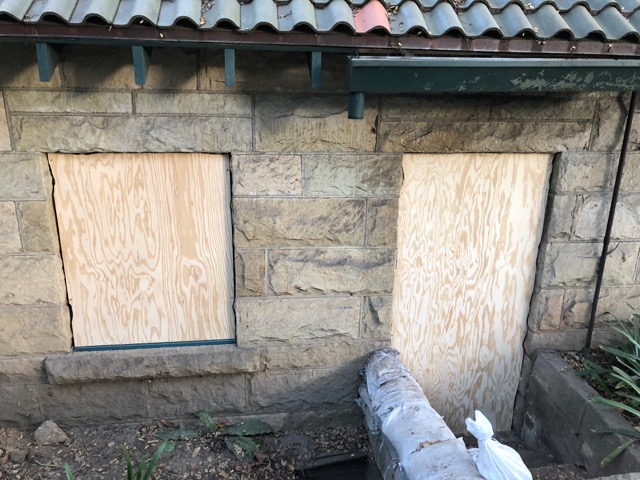Disaster Recovery
I thought our community might like to see how other Montecito residents are coping with our recent disasters. Like many others, my wife, Nancy, and I were suffering from evacuation fatigue after the Thomas Fire and decided when authorities ordered a second evacuation for a winter storm, that our home was far enough away from a creek and that we would not be in immediate danger in the event of a flash flood.
The early morning events of January 9 proved that we were wrong in our assumptions; the debris flow damaged or destroyed many homes in our community, and we experienced mud and debris flowing across a portion of our garden. Fortunately for us, our home and my studio survived unscathed, but after experiencing the debris flow first-hand, I felt that we should take immediate actions to protect our home from a potential second debris flow.
My studio (a little stone building) was the most at risk, so with a series of storms forecast in the coming days, I chose to board up the windows with plywood to protect the structure. Nancy understood the need, but thought it made the property look abandoned and suggested that my niece, Maddie, and I paint the plywood panels to make the little stone structure look more lived-in.
Maddie, Nancy, and I spent a Sunday afternoon painting. I was not sure how this was going to turn out, but thought it might be good therapy and might just bring a little color to our ravaged neighborhood. I will let the readers judge for themselves, but I will add that it was therapeutic and that I still feel joy when I pass by.
Thomas Bollay
Montecito

MUS Sacrifices in Order
A week ago, my family – like all the others in our class – received very sad news. Our teacher was about to be fired by MUS. We could not believe it: our wonderful teacher with great experience and amazing, kind, attentive attitude toward our kids would lose her position and will no longer be a part of our life and the beautiful Montecito community. Some of you may say: “Well, life is life.” And on some level, I can agree with that. Montecito has been through a lot lately: drought, fire, mudslide. There is no way it would not affect people who live here and some sacrifices are inevitable.
Obviously, property taxes are down and when that happens, budgets shrink. That’s what happened to all of us, and even our “perfect” school was affected. But there are many ways to deal with consequences like that when you are as strong as our community and want to find the right and smart way instead of the path of least resistance.
I can give you a very simple example I came across a few days ago. One worker in Germany lost his wife and his son got sick with cancer. The devastated father thought he had no other options but to leave his job to stay with his son. He was a good worker and… German coworkers decided to spread his hours among themselves to help him not only to save his job, but also able to receive a salary. All together, his colleagues worked 3,264 hours for him, which is about 400 days.
Andreas Gaff (the name of the father) was able to not just save his position at work and have money for his child, not just feel honored to be a part of a strong community, but a very important part indeed. And that’s how it’s supposed to be in a civilized world such as ours. One for all and all for one. Especially for one as important in creating great future people as a teacher.
It’s easy to say “Goodbye,” but harder to say “Let’s think what we can do to stay together,” and that’s what MUS has obviously forgotten how to do.
Let me walk you through some basic facts. We have a tiny district with two schools. Montecito Union has 390 kids, and the numbers are 20 percent down after all the debris flow events. Apparently, the first thing that came to their minds: let’s fire some teachers.
That cannot be more wrong.
There is no such thing as having too many people watching your kids. I know it; I have five. There is no such thing as having too many smart people teaching your kids. Amazingly, besides all the numbers that are about to change in MUS, one number is going to stay the same: the number of administrative (i.e., not directly participating in the teaching process) personnel. Our tiny district with [fewer] kids than ever will have [fewer] teachers but way too many administrators. The number of administrators per kid is actually increasing as the number of kids goes the opposite way.
That does not make any sense.
MUS has one superintendent, one principal, and one vice principal. Why do we need three administrators, each with six-figure salaries? Why not five, or eight? Do we really need them all? What exactly do they do to improve our children’s education? It’s just a tiny community with 10,000 people.
The salary of the principal is twice as high as the salary of one teacher. Why do they want to affect the learning process, the lives of the kids they’re supposed to serve, the lives of the teachers, the teachers’ kids (who will probably not be able to attend MUS any longer) and not want to get rid of unnecessary expenses at the top? Alternatively, they simply can be more thoughtful and reasonable and (the German way described earlier), take full responsibility (at the end, it’s all about money) as captains of their own ship and help those teachers in need by spreading the missing parts of the budget, cutting the fat in their own salaries and giving it to the teachers.
I am sure as good friends, great faculty, and wonderful humans, the teachers will also be happy to share a tiny part of their salary with others. This way, the number of teachers per kid will actually increase and our MUS district will show an even higher quality of education, hopefully luring in more families, which will improve the overall status of our sad, depressed community. How hard is it to figure that out? And of course, all that sacrifice is needed only temporarily until everything is back to normal. Let the MUS community show the real face of brotherhood, strong responsibility, and kind feelings for each of its members instead of just proclaiming it in generally meaningless emails while apparently not practicing what is being preached. Such a temporary solution – assuming Montecito will bounce back in a few years – will not just make us stronger in words, but in real life.
Save the teachers.
Save our community.
Save our kids and their education!
Lidia Zinchenko
Montecito
MUS Responds
Staffing reductions are difficult for any organization, and perhaps especially difficult in a school, as the teachers and other staff members who work with children deserve both our admiration and respect. It is especially difficult to let go of staff members in a year like this one, when they have done so much for our students during challenging times. When reductions in a school are needed, they should be done thoughtfully, and should be spread out throughout all the areas of the school organization.
That is what we have done.
At Montecito Union School (MUS), we are faced with two separate challenges: the prospect of reduced income of perhaps 13 percent or more, and declining student enrollment. To be clear, the enrollment decline of 20 percent was not a direct result of the Thomas Fire and Debris Slide. This 20-percent decline took place over seven years and is largely the result of demographic shifts. With fewer students and less income, it is prudent to reduce the budget. The Board of Trustees has done that, but we will still be using reserves and deficit spending next year, even with these reductions. Our reserves were built over time for a reason: as a protection from a sudden, unexpected event… and that’s certainly what this community has experienced.
We’ve reduced expenditures across all areas of the budget. I have voluntarily forgone the contractual raise that was set to kick in automatically in the next school year. The principal, assistant principal, and chief business officer have all reduced their workdays, and thus their salary. Please note that administrators do receive a higher salary than our teachers, but they work many more days of the year and longer hours in those days, so their “hourly rate” is quite similar to our teaching staff. Every member of the business office will see their hours and salary cut, and we have reduced school office support as well. We’ve also reduced spending in technology, professional development, school supplies, subscriptions, and other areas in an attempt to save as many positions as possible.
It is never easy to reduce our teaching force. The fact is, this year we have some classes that are at 12 students. There is not a sound educational reason for class sizes to be so low, and our teachers agree it is not even in the students’ best interests. We plan to go from 26 classes to 22 classes, while still maintaining a low school average of 18 students per class. Even if we were not facing significant revenue reductions, it would still be appropriate to make these reductions. To be clear, these particular reductions are a function of our student numbers and not our revenue. We have one retirement this year, and one teacher had a creative solution with a voluntary leave for a portion of the year. Taken together, this saves two teaching positions.
Unfortunately, that still means we have to say goodbye to two excellent teachers. We will also need to reduce some instructional assistant positions as a result of this reduction of classes, but we hope we can do that by natural attrition. Finally, as we have reduced classes, we can reduce services needed in each of our specialist areas, and this is a complex process that is ongoing.
During these expenditure reductions, I have worked hard to consult the teachers as I prepared my recommendations and the teacher’s union wrote a letter in support of our decisions. Here is their March 5 public comment, in full:
“My name is Jeff Linder and I am here to speak on behalf of the Montecito Teachers Union. At the February 20 meeting, Barbara Gonzales shared that the majority of the teachers are in support of tier 1 cuts. Tier 1 being defined as reductions due to right-sizing associated with decreasing student enrollment. Although we stand to lose some amazing teachers, colleagues, and personal friends, we believe these reductions are what is best for the Montecito Union School Community.
“As MTA leadership, we represent the Montecito Union Teachers as a whole above any specific individuals. At times, we make recommendations against the desires of individuals, for the overall group. Today we are here to do the same. This past, we collected additional teacher survey data to determine if MTA supporting Tier 1 cuts included all recommendations or excluded a specific department. It was reaffirmed that we stand behind all recommendations for Tier 1 reductions as the premises for those cuts is not to change the student experience at MUS and only to reduce due to student enrollment. Less students means we have a need for fewer classes and fewer teachers. With fewer classes we need fewer specialist hours. We are in support of our same great PE, music, library, art, and Spanish programs. With less students, those programs need less hours to maintain their same excellence.
“Let’s use the library as an example. Mrs. Yungling sees classes in the library for a minimum of 30 minutes a week. With a reduction of 4 classes, Mrs. Yungling has at least 2 hours a week of less time with students. She also has four less classes to get ready for. The proposal is to reduce the library from a full time position to an 80% position. That reduction of 20% has an effect on Mrs. Yungling, but does not change the amount of minutes students visit the library. To the students, the library next year will be the same as it is this year.
“We have a desire to preserve the amazing educational experience for the students. From the classroom learning environment, to our specialists programs, Montecito Union is a special place. We thank the school board for allowing reserves to be used to preserve that student experience. Please spend those reserves wisely. We ask that you consider the MUS learning community as a whole and continue to move forward for what is best for kids.”
No “Unnecessary Expenses”
I’d like to reiterate that even with the above reductions, we expect to deficit spend next year out of our reserves: that’s what reserves are for. This community will rebuild. It will never be the same, and we’ve lost people and seen neighborhoods altered in significant ways. That said, the long-term future is bright, and we’re betting on this reduced funding as a temporary issue. Our expenditure reductions will slow our use of reserves but are not designed to prevent the use of them.
We do have a relatively small one-school district, and even with the cuts to administration, I think it is fair to call our administrative staff into question. When I made my recommended expenditure reductions to the board, I made clear that we could need to make further reductions in the future. I recommended a “Tier 1” set of reductions, which I have described above, but I also explained a “Tier 2” and a “Tier 3” set of recommendations, which included further reductions to administration, including reducing the overall number of administrators. We could be at that point in the future.
That said, I am proud of the MUS staff for extraordinary efforts this year to keep the kids safe and to keep the learning process going by holding classes at the Santa Barbara Zoo, Moxi Museum, Santa Barbara City College, McKinley School, Summerland School, and the Hope Elementary School District through rounds of exclusion zones and evacuations. The teachers, support staff, facilities crew, and parent volunteers are to be commended for this Herculean effort.
But I would be remiss if I didn’t also commend the administrative team, who worked nights, devoted weekends, and devoted long days this year to these students. Leadership matters, and at a time like this, it makes a real difference to the student experience. We have cut administrative salaries and central office staffing, and we may need to make deeper cuts in the future. That said, in this year more than most, the administrative team has not been an “unnecessary expense.”
Anthony Ranii
Superintendent, MUS District
Warehousing not “Care”
My friend, Madame X, who is in her mid-80s, was plucked from her home in Montecito during the evacuations in early December. Just before that, I drove by and gave her a dust mask. In the following weeks, I phoned but never got an answer. Finally, just after the debris flow, I called the sheriff. Within minutes, they had entered the house and called me to say all looked fine, but no one was there. Her car was in the garage.
As far as I know, she has no family. My concern grew. Where was she? After some sleuthing, I found her in a care facility. She had been evacuated by authorities going house to house. On the phone, she sounded fine and glad to hear from me. She wanted to see her house, and I agreed to take her the next day. It was not long before I received a call from the facility telling me that the trip was not possible and warning me to not cause trouble.
She has been institutionalized without her consent. I have visited her a few times in the last month. Her first words to me were, “I am in a loony bin.”
It was not an attempt at humor.
Safety is not the only criterion for living well. There is no doubt many sincere, professional people are responsible for Madame X’s life, but for her, warehousing is not care.
Gerald Rounds
Montecito
Transforming Montecito
Regarding your Editorial (“A New Montecito,” MJ #24/10): In 1925, Pearl Chase had the vision to see how the devastation caused by the Santa Barbara earthquake could transform the city from the Victorian image it had been into the Spanish Revival enclave it became.
What you recommended we do is exactly what I have been suggesting in recent conversations. Through planning initiatives and financial incentives, Montecito could become more beautiful than ever.
We should put together a committee of visionaries to make this happen before this magnificent opportunity slips through our busy fingers.
Ray Bourhis
Montecito/San Francisco
(Editor’s note: Thank you for the optimism for Montecito, which we share. We’ll continue stressing the positive changes and efforts we and other residents can promote, such as fully undergrounding utility wires and poles, securing a permanent and reliable water supply, speeding up the building permit process for affected homes, replacing bridges quickly, and expediting the widening of Highway 101, along with other incidental efforts. – J.B.)
Recovery and Rebirth
Frequently, we drive between our village of Montecito and Westlake Village. For miles and miles, the scorched and barren hillsides are a stark reminder of the Thomas Fire devastation; it seems impossible that an area so vast was in flames in December, especially knowing that it represents a very small portion of the entire burn area.
Recently, we couldn’t help but notice – with wonder and relief – that here and there were patches of green and just a whisper of new growth beneath the black shadow of burned scrub. Mother Nature is making a comeback, albeit slow and low. If only rebuilding our community of homes and trees and roads and bridges were so natural and inevitable. From the steady progress visible all around us though, we are witness to the indomitable human spirit that prevails – a potent symbol of our community’s supernatural strength to overcome the deathly toll taken by the mud and boulders and debris that attacked us on January 9.
Our heartfelt wishes for recovery and rebirth for everyone living or working in Montecito – especially all of you who lost business, your job, your home, your loved ones.
Diane and Garrett Graham
Montecito
Open Those Lanes
Bob Hazard’s recent editorial regarding the need to open Highway 192 is absolutely correct (“Building Bridges,” MJ #24/11) and it appears county and state personnel are handling this as a business-as-usual approach. I have personally talked to personnel at both levels and pleas asking to improve the situation have fallen on deaf ears.
I live in the Toro Canyon area and would like to offer some additional ideas to improve the traffic flow through our area. My observations are for the Toro Canyon-Ladera-Freehaven area only, but I suspect other areas have similar situations.
While the idea of adding temporary bridges has merit, I suggest using the bridges as they are. Prior to the closing of Toro east, 80 dump trucks a day carried their loads (40,000 pounds each) from the Toro debris basin across the bridge. After the bridge was closed, excavators (40,000+ pounds) routinely worked from the bridge moving boulders. After watching all this, I question whether the bridge is truly unsafe for passenger car traffic. The rails are gone from this bridge, but K rails could be easily added and the bridge re-opened as a single lane. After permits for rebuilding the bridge are approved and the crew is on site to do demo work, the bridge could then be shut down until it is rebuilt. Perhaps this approach could apply to other bridges as well.
Two other things could be implemented immediately to help traffic flow in the Ladera-Toro Canyon-Freehaven area.
Currently, all traffic to and from our area (including all heavy trucks and construction personnel) are forced to use Ortega Ridge Road in order to go anywhere. This means all traffic starts or ends up at the Ortega Ridge-Ortega Hill intersection, which is very congested and that ripples to 101. This traffic could be mitigated somewhat by reopening Greenwell Road through Summerland. Currently, Greenwell has been shut down and is being used as a dirt dump. This is a perfectly viable road that, if opened, would allow people coming from or going to the south to bypass the Ortega Ridge-Hill intersection. Calls to the County asking why Greenwell is closed have yielded responses of it will be closed until the rainy season is over, but no explanation has been given as to why it is closed. There is absolutely no good reason why one of the few good roads in our area is closed and being used as a dump.
Five plus years ago, the County closed one lane of Ortega Ridge to traffic due to one lane sinking a few inches. They have never fixed this, and so Ortega Ridge is only one lane for a short distance and traffic going both directions is forced to stop at “temporary” stop signs. The County needs to step up and remedy this issue and open both lanes.
Many in the area have contacted Das Williams’s office, Salud Carbajal’s office, County Public Works, and Caltrans, but as stated above, it seems to be business as usual for all of them. Thanks for trying to bring some urgency and offering alternative thinking to the situation. I hope some of it gets through to the right people and we start to see some positive changes.
Jay Peterson
Montecito
Falling Flat
Isn’t it amazing how we change in 23 years? I came to Santa Barbara (from the Pennsylvania 18th Congressional District, no less) in June 1995. You founded the Montecito Journal almost at the same time. You handed over editorial duties in the most current issue to Jeff Harding, to answer a letter-writer on Trump’s tariffs, etc. (“Looking For Help,” MJ #24/11). I scanned Mr. Harding’s response in 45 seconds. It’s something I would have said myself back in 1995, when our Congresswoman was Andrea Seastrand.
Today? It falls flat like warm spit.
Enlightenment-based political ideology just doesn’t make it with me anymore. There’s a whole lot going on in my cranium; it would take a 15,000-word essay in The Atlantic to sort everything out. But I think it’s fair to say my transition from “West” to “East” began with Natalia Nikolenko Lambert in 1997. John Locke, Edmund Burke, and Voltaire – heck, not even Blaise Pascal, does it for me these days. I’m very comfortable with my new paths.
On another subject, I have no reason to question the letter-writer who says Katy Perry has been talking about babies and children for 10 years (“Baby Talk,” MJ #24/11). It’s just that I’ve never come across these wishes. I am “softening” on Katy Perry because there’s evidence her long-standing hostility and resentment toward her parents is mellowing, and the fact you alluded to: her talent is improving and broadening as she matures.
She’s not a one-dimensional performer.
As for her insistence on searching only the U.K. for marriage material, I give people huge latitude. My only objection would be a “revenge” marriage candidate. “Global” female celebrities say we American men are “immature.”
Maybe, maybe not.
There’s got to be one American guy in his 30s in SoCal worth $100 million who isn’t immature.
David McCalmont
Santa Barbara
(Editor’s note: I guess I made a mistake asking Mr. Harding to respond to the “Looking For Help” letter, but Jeff has strong views on the subject of tariffs and free trade, so I believed we would be better served if he responded. However, because I penned the opinion that I didn’t agree with much of what he had written, he took serious umbrage at my comments. Which is a shame, as he has informed takes on many subjects and I meant no disrespect. Perhaps he’ll reconsider.
As for Ms Perry, yes indeed, she is a top talent and I fully expect her to continue to command center stage for decades to come. – J.B.)













You must be logged in to post a comment.